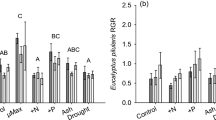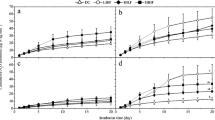Abstract
Total soil available nitrogen concentrations (NO–3 + NH +4 ) were determined underneath plants of the more-competitive Poa ligularis, mid-competitive Nassella tenuis and the less-competitive Amelichloa ambigua exposed to various combinations of controlled burning and defoliation treatments. Defoliations were at the vegetative (V), internode elongation (E) or both developmental morphology stages (V + E) during two years after burning in northeastern Patagonia, Argentina. Hypotheses were that (1) concentrations of total soil available nitrogen after burning are greater underneath burned than unburned plants. With time, these differences, however, will gradually disappear; (2) greater total soil available nitrogen concentrations are underneath plants of the more- than less-competitive perennial grasses; and (3) total soil available nitrogen is similar or lower underneath plants defoliated at the various developmental morphology stages in all three study species than on untreated controls at the end of the study. Concentration of total soil available nitrogen increased 35% (p < 0.05) on average after the first six months from burning in comparison to control plants. However, these differences disappeared (p > 0.05) towards the end of the first study year. Total soil available nitrogen concentrations were at least 10% lower underneath the less competitive N. tenuis and A. ambigua than the more competitive P. ligularis on average for all treatments, although differences were not significant (p > 0.05) most of the times. Defoliation had practically no effect on the concentration of total soil available nitrogen. Rather than any treatment effect, total soil nitrogen concentrations were determined by their temporal dynamics in the control and after the experimental fire treatments.
Similar content being viewed by others
References
Aerts, R. and De Caluwe, H, Nutritional and plant mediated controls on leaf litter decomposition of Carex species, Ecology, 1997, vol. 78, pp. 244–260.
Ahlgren, I.F. and Ahlgren, C.E, Effects of prescribed burning on soil microorganisms in a Minnesota Jack Pine Forest, Ecology, 1965, vol. 46, pp. 304–310.
Albanesi, A. and Anriquez, A., El fuego y el suelo, Kunst, C., Bravo, S., and Panigatti, J.L., Eds., Fuego en los ecosistemas argentinos, Santiago del Estero (Argentina): Editorial INTA, 2003, pp. 47–59.
Ambrosino, M., Busso, C., Minoldo, G., Martinez, J., Cardillo, D., Torres, Y., Ithurrart, L., Montenegro, O., Munch, M., Ponce, D., Giorgetti, H., and Rodríguez, G., Descomposición de broza de gramíneas perennes en los pastizales naturales, XIV Congreso Argentino de la Ciencia del Suelo y IIReunión Nacional “Materia Orgánica y Sustancias Húmicas”, Buenos Aires, Bahía Blanca, 5 al 9 de mayo de 2014, 2014a.
Ambrosino, M., Busso, C., Minoldo, G., Martinez, J., Torres, Y., Montenegro, O., Ithurrart, L., Cardillo, D., Montani, T., Ponce, D., Giorgetti, H., and Rodríguez, G., Producción de broza foliar de Poa ligularis, Nassella tenuis y Amelichloa ambigua, XIV Congreso Argentino de la Ciencia del Suelo y II Reunión Nacional “Materia Orgánica y Sustancias Húmicas”, Buenos Aires, Bahía Blanca, 5 al 9 de mayo de 2014, 2014b.
Anderson, D.L, Compatibilidad entre pastoreo y mejoramiento de los pastizales naturales, Producción Animal 10, 1983, pp. 3–22. www.produccionanimal.com.ar.
Anderson, D.L, El fuego como elemento de manejo del pastizal natural, EEA INTA San Luis, V. Mercedes, Informativo Rural, 1984, vol. 20, pp. 3–4. www.produccionanimal. com.ar.
Anderson, T.M., Starmer, W.T., and Thorne, M, Bimodal root diameter distributions in Serengeti grasses exhibit plasticity in response to defoliation and soil texture: Implications for nitrogen uptake, Functional Ecol., 2007, vol. 21, pp. 50–60.
Arocena, J.M. and Opio, C, Prescribed fire-induced changes in properties of sub-boreal forest soils, Geoderma, 2003, vol. 113, pp. 1–16.
Blair, J.M, Fire, Navailability, and plant response in grasslands: A test of the transient maxima hypothesis, Ecology, 1997, vol. 78, pp. 2359–2368.
Bogen, A.D., Bork, E.W., and Willms, W.D, Defoliation impacts on Festuca campestris (Rydb.) plants exposed to wildfire, J. Range Manag., 2003, vol. 56, pp. 375–381.
Bóo, R.M. and Peláez, D.V, Ordenamiento y clasificación de la vegetación en un área del Sur Del Distrito del Caldén, Boletín de la Sociedad Argentina de Botánica, 1991, vol. 27, pp. 135–141.
Bóo, R.M., Peláez, D.V., Bunting, S.C., Elia, O.R., and Mayor, M.D, Effect of fire on grasses in central semi-arid Argentina, J. Arid Environ., 1996, vol. 32, pp. 259–269.
Brown, R.W., The water relations of range plants: adaptations to water deficits, Bedunah, D.J. and Sosebee, R.E., Eds., Wildland Plants: Physiological Ecology and Developmental Morphology, Denver (USA): Society for Range Management, 1995, pp. 635–710.
Busso, C.A., Brevedan, R.E., Flemmer, A.C., and Bolletta, A.I., Morphophysiological and demographic responses of perennial grasses to defoliation under water stress, Hemantaranjan, A., Ed., Plant Physiology and Plant Molecular Biology in the New Millennium. Advances in Plant Physiology, Vol. V, Jodhpur: Scientific Publishers, 2003, pp. 341–395 (India). http://www.angelfire.com/ak5/adv_pp/index.htm.
Cabrera, A.L., Regiones fitogeográficas Argentinas, Ferreira Sobral, E.F., Ed., Enciclopedia Argentina de Agricultura y Jardinería, Buenos Aires: ACME, 1976, pp. 1–85.
Cano, E., Pastizales naturales de La Pampa, Descripción de las especies más importantes, Buenos Aires: Convenio AACREA–Provincia de La Pampa,1988, p. 438.
Celaya Michel, H. and Castellanos Villegas, A.E., Mineralización de nitrógeno en el suelo de zonas áridas y semiáridas, Terra Latinoamericana, 2011, vol. 29, pp. 343–356.
Coleman, D.C., Reid, C.P.P., and Cole, C.V, Biological strategies of nutrient cycling in soil systems, Adv. Ecol. Res., 1983, vol. 13, pp. 1–55.
Soil factors affecting nutrient bioavailability, Bassiri-Rad, H, Ed., Ecological Studies, 2005, vol. 181, pp. 1–5
Comerford, N.B., Nutrient Acquisition by Plants, An Ecological Perspective, Berlin (Germany): Springer-Verlag,2005, p. 348.
Daubenmire, R., Ecology of fire in grasslands, Craig, J.B., Ed., Advances in Ecological Research, New York (USA): Academic Press, 1968, pp. 209–266.
DeBano, L.F., Neary, D., and Folliott, P.F., Fire’s Effects on Ecosystems, New York (USA): John Wiley and Sons, 1998.
Di Rienzo, J.A., Casanoves, F., Balzarini, M.G., Gonzalez, L., Tablada, M., and Robledo, C.W., Argentina: INFOSTAT Grupo INFOSTAT, FCA, Universidad Nacional de Córdoba, 2013.
Distel, R.A. and Bóo, R.M., Vegetation states and transitions in temperate semiarid rangelands of Argentina, West, E.N., Ed., Proceedings of the Vth International Rangeland Congress, Rangelands in a Sustainable Biosphere, Salt Lake City (USA): Society for Range Management, 1996, pp. 117–118.
Fenn, M.E., Poth, M.A., Aber, J.D., Baron, J.S., Bormann, B.T., Johnson, D.W., Lemly, A.D., McNulty, S.G., Ryan, D.F., and Stottlemyer, R, Nexcess in North American ecosystem: Predisposing factors, ecosystem responses, and management strategies, Ecol. Appl., 1998, vol. 8, pp. 706–733.
Fernández, O.A. and Busso, C.A., Arid and semi-arid rangelands: Two thirds of Argentina, Arnalds, O. and Archer, S., Eds., Case Studies of Rangeland Desertification, Reykjavik (Iceland): Agricultural Research Institute Report,1999, no. 200, pp. 41–60.
Giardina, C.P., Sanford, J, and Dockersmith, I.C, Changes in soil phosphorus and nitrogen during slash and burn clearing of a dry tropical forest, Soil Sci. Soc. Am. J., 2000, vol. 64, pp. 399–405.
Giorgetti, H., Montenegro, O.A, Rodríguez, G.D., Busso, C.A., Montani, T., Burgos, M.A., Flemmer, A.C., Toribio, M.B., and Horvitz, S.S., The comparative influence of past management and rainfall on range herbaceous standing crop in east-central Argentina: 14 years of observations, J. Arid Environ., 1997, vol. 36, pp. 623–637.
Harris, W.N., Moretto, A.S., Distel, R.A., Boutton, T.W., and Bóo, R.M, Fire and grazing in grasslands of the Argentine Caldenal: Effects on plant and soil carbon and nitrogen, Acta Oecologica, 2007, vol. 32, pp. 207–214.
Hepper, E., Urioste, A., Belmonte, V., and Buschiazzo, D, Temperaturas de quema y propiedades físicas y químicas de suelos de la región semiárida pampeana central, Ciencia del Suelo, 2008, vol. 26, pp. 29–34.
Hoglund, J.H, Grazing intensity and soil nitrogen accumulation, Proceedings of the New Zealand Grassland Association, 1985, vol. 46, pp. 65–69. https://www.nrcs.usda.gov/wps/PA_NRCSConsumption/dowload?cid=stelprdb124337&ext=pdf. Soil quality indicators. USDA Natural Resources Conservation Service. Accesses January 24, 2016.
Hubbert, K.R., Preisler, H.K., Wohlgemuth, P.M., Graham, R.C., and Narog, M.G, Prescribed burning effects on soil physical properties and soil water repellency in a steep chaparral watershed, southern California, USA, Geoderma, 2006, vol. 130, pp. 284–298.
INTA-CIRN, Mapa de suelos de la provincia de Buenos Aires, Buenos Aires: Instituto Nacional de Tecnología Agropecuaria, Centro de Investigación de Recursos Naturales, Instituto de Evaluación de Tierras, 1989, p. 525.
Ithurrart, L.A, Efectos de la defoliación luego de la quema de gramíneas perennes nativas palatables y no palatables en el Sudoeste Bonaerense, Doctoral Thesis, Bahía Blanca (Argentina): Departamento de Agronomía, Universidad Nacional del Sur, 2015, p. 204.
Knops, J.M.H., Bradley, K.L., and Wedin, D.A, Mechanisms of plant species impacts on ecosystem nitrogen cycling, Ecol. Lett., 2002, vol. 5, pp. 454–466.
Kovacic, D.A., Swift, D.M., Ellis, J.E., and Hankonson, T.E, Immediate effects of prescribed burning on mineral soil N in ponderosa pine of New Mexico, Soil Sci., 1986, vol. 141, pp. 71–76.
Li, W., Huan, H.Z., Shang, Z.N., and Wu, G.L, Effects of grazing on the soil properties and C and N storage in relation to biomass allocation in an alpine meadow, J. Soil Sci. Plant Nutrition, 2011, vol. 11, pp. 27–39.
Moretto, A. and Distel, R, Soil nitrogen availability under grasses of different palatability in a temperate semiarid rangeland of central Argentina, Austral Ecol., 2002, vol. 27, pp. 509–514.
Moretto, A. and Distel, R, Decomposition of and nutrient dynamics in leaf litter and roots of Poa ligularis and Stipa gyneriodes, J. Arid Environ., 2003, vol. 55, pp. 503–514.
Mulvaney, R.L., Khan, S.A., Stevens, W.B., and Mulvaney, C.S, Improved diffusion methods for determination of inorganic nitrogen in soil extracts and water, Biol. Fertility Soils, 1996, vol. 24, pp. 413–420.
Picone, L., Quaglia, G., García, F., and Laterra, P, Biological and chemical response of a grassland soil to burning, J. Range Manag., 2003, vol. 56, pp. 291–297.
Raison, R.J, Modification of the soil environment by vegetation fires, with particular reference to N transformations: A review, Plant Soil, 1979, vol. 51, pp. 73–108.
Renbuss, M.A., Chilvers, G.A., and Pryor, L.D, Microbiology of an ashbed, Proceedings of the Linnean Society of New South Wales, 1973, vol. 97, pp. 302–311.
Ritchie, M.E., Tilman, D., and Knops, J.M.H, Herbivore effects on plant and nitrogen dynamics in oak savanna, Ecology, 1998, vol. 79, pp. 165–177.
Saint Pierre, C., Busso, C.A., Montenegro, O.A., Rodríguez, G.D., Giorgetti, H.D., Montani, T., and Bravo, O, Root proliferation in perennial grasses of low and high palatability, Plant Ecol., 2002, vol. 165, pp. 161–169.
Saint Pierre, C., Busso, C.A., Montenegro, O.A, Rodríguez, G.D., Giorgetti, H.D., Montani, T., and Bravo, O., Direct assessment of competitive ability and defoliation tolerance in perennial grasses, Can. J. Plant Sci., 2004a, vol. 84, pp. 195–204.
Saint Pierre, C., Busso, C.A., Montenegro, O.A., Rodríguez, G.D., Giorgetti, H.D., Montani, T., and Bravo, O, Defoliation tolerance and ammonium uptake rate in perennial tussock grasses, J. Range Manag., 2004b, vol. 57, pp. 82–88.
Saint Pierre, C., Busso, C.A., Montenegro, O.A., Rodríguez, G.D., Giorgetti, H.D., Montani, T., and Bravo, O, Soil resource acquisition mechanisms, nutrient concentrations and growth in perennial grasses, Interciencia, 2004c, vol. 29, pp. 303–311.
Semmartin, M., Piñeiro, G., Altesor, A., and Paruelo, J, Efectos del pastoreo vacuno sobre la dinámica del nitrógeno y la biota del suelo en un pastizal subhúmedo, XXII Reunión Argentina de Ecología, Córdoba, 2006.
Sokal, R.R. and Rohlf, F.J., Introducción a la Bioestadística, Barcelona: Editorial Reverté S.A., 1984, p. 804.
Tilman, D. and Wedin, D, Dynamics of nitrogen competition between successional grasses, Ecology, 1991, vol. 72, pp. 1038–1049.
Wan, S., Hui, D., and Luo, Y, Fire effects on nitrogen pools and dynamics in terrestrial ecosystems: A metaanalysis, Ecol. Appl., 2001, vol. 11, pp. 1349–1365.
Wedin, D.A. and Pastor, J, Nitrogen mineralization dynamics in grass monocultures, Oecologia, 1993, vol. 96, pp. 186–192.
Author information
Authors and Affiliations
Corresponding author
Additional information
The article is published in the original.
Rights and permissions
About this article
Cite this article
Ithurrart, L.S., Busso, C.A., Torres, Y.A. et al. Total soil available nitrogen under perennial grasses after burning and defoliation. Russ J Ecol 48, 122–133 (2017). https://doi.org/10.1134/S1067413617220015
Received:
Published:
Issue Date:
DOI: https://doi.org/10.1134/S1067413617220015




